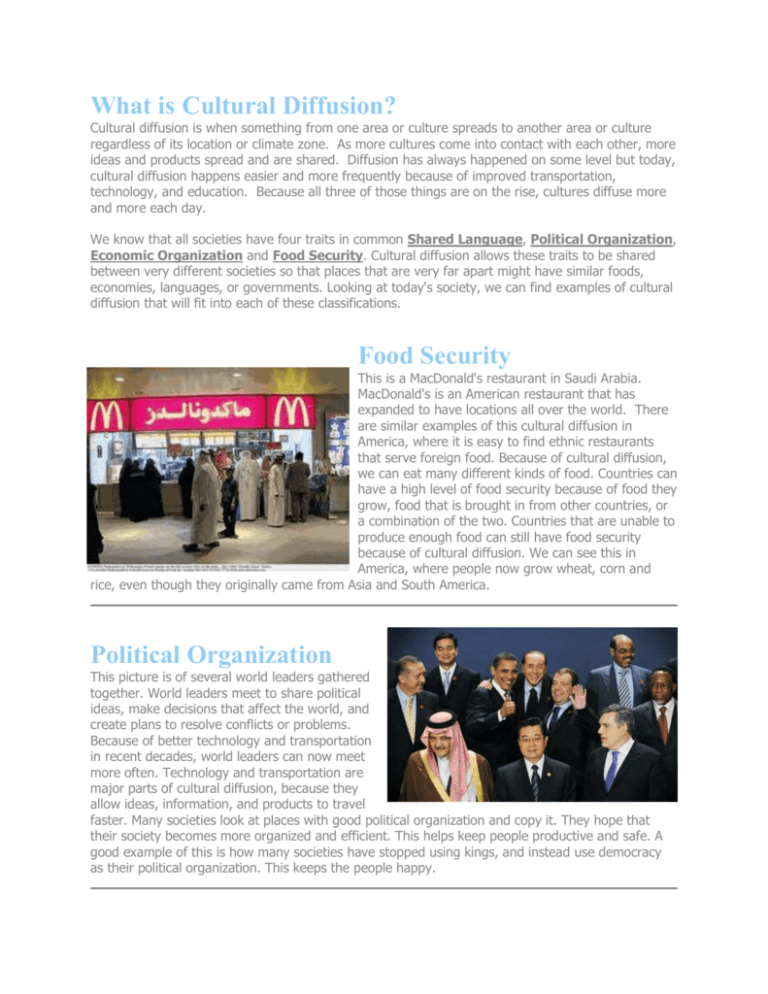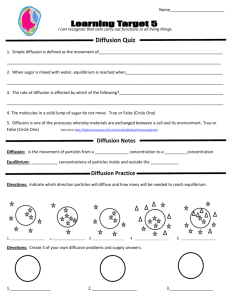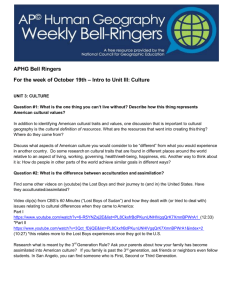What is Cultural Diffusion 2014-15
advertisement

What is Cultural Diffusion? Cultural diffusion is when something from one area or culture spreads to another area or culture regardless of its location or climate zone. As more cultures come into contact with each other, more ideas and products spread and are shared. Diffusion has always happened on some level but today, cultural diffusion happens easier and more frequently because of improved transportation, technology, and education. Because all three of those things are on the rise, cultures diffuse more and more each day. We know that all societies have four traits in common Shared Language, Political Organization, Economic Organization and Food Security. Cultural diffusion allows these traits to be shared between very different societies so that places that are very far apart might have similar foods, economies, languages, or governments. Looking at today's society, we can find examples of cultural diffusion that will fit into each of these classifications. Food Security This is a MacDonald's restaurant in Saudi Arabia. MacDonald's is an American restaurant that has expanded to have locations all over the world. There are similar examples of this cultural diffusion in America, where it is easy to find ethnic restaurants that serve foreign food. Because of cultural diffusion, we can eat many different kinds of food. Countries can have a high level of food security because of food they grow, food that is brought in from other countries, or a combination of the two. Countries that are unable to produce enough food can still have food security because of cultural diffusion. We can see this in America, where people now grow wheat, corn and rice, even though they originally came from Asia and South America. Political Organization This picture is of several world leaders gathered together. World leaders meet to share political ideas, make decisions that affect the world, and create plans to resolve conflicts or problems. Because of better technology and transportation in recent decades, world leaders can now meet more often. Technology and transportation are major parts of cultural diffusion, because they allow ideas, information, and products to travel faster. Many societies look at places with good political organization and copy it. They hope that their society becomes more organized and efficient. This helps keep people productive and safe. A good example of this is how many societies have stopped using kings, and instead use democracy as their political organization. This keeps the people happy. Shared Language Literacy, the ability to read and write, is rising in developing countries. Because of cultural diffusion, the education systems and resources of developed countries are starting to transfer to developing countries. Textbooks, novels, and other resources can be shared, resulting in higher literacy rates and an increase in shared language. This graph shows the rising literacy rates of Pakistan over the last several decades. Books from English speaking countries can be shared with Pakistan because schools in Pakistan instruct in both English and the native language Urdu. Without cultural diffusion, it is unlikely that we would see this same rise in literacy. Because of the spread of English through education, more people can communicate with each other than ever before. Some societies have decided to use another cultures’ language to give them an advantage. If they speak the “right language” they might get more trade partners, or can use another cultures’ books to learn new ideas. Economic Because of Cultural Diffusion, we can exchange goods between many different societies, rather than just within our own society. This also means that we can have a greater variety of products. This map of international trading blocs shows how economics are affected by cultural diffusion. Different countries have control over different resources that are necessary for making products we use every day. Improved transportation means that products can be manufactured (made) in many faraway countries. For instance, the shoes you are wearing were probably not manufactured in the United States. Each portion of your shoe probably came from a different country that controlled that resource. The fabric or leather comes from one place while the rubber sole comes from someplace else. Because it is now common to use products that were manufactured all over the world, economics are very heavily affected by cultural diffusion. Countries must work together and negotiate to share resources controlled by individual countries. This helps trading. If a society can trade for the food or technology that does not naturally occur in their geographic location, they can more easily access their wants and their needs.









